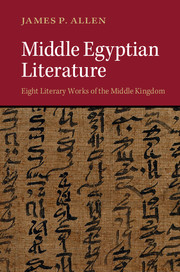Book contents
- Frontmatter
- Contents
- Introduction
- Text 1 The Story of the Shipwrecked Sailor
- Text 2 The Story of Sinuhe
- Text 3 The Loyalist Instruction
- Text 4 The Instructions of Kagemni's Father and Ptahhotep
- Text 5 The Discourses of the Eloquent Peasant
- Text 6 The Debate between a Man and His Soul
- Text 7 The Herdsman's Tale
- Text 8 Hymns to Senwosret III
- Consecutive Translations
Text 4 - The Instructions of Kagemni's Father and Ptahhotep
Published online by Cambridge University Press: 05 January 2015
- Frontmatter
- Contents
- Introduction
- Text 1 The Story of the Shipwrecked Sailor
- Text 2 The Story of Sinuhe
- Text 3 The Loyalist Instruction
- Text 4 The Instructions of Kagemni's Father and Ptahhotep
- Text 5 The Discourses of the Eloquent Peasant
- Text 6 The Debate between a Man and His Soul
- Text 7 The Herdsman's Tale
- Text 8 Hymns to Senwosret III
- Consecutive Translations
Summary
These two texts are preserved on a single Middle Kingdom papyrus, known as Papyrus Prisse, now in the Bibliothèque Nationale in Paris. It is written in hieratic in horizontal lines; that feature and the style of its handwriting suggest a date in the second half of the Middle Kingdom, probably the reign of Amenemhat III, although the text itself may have been composed as early as the beginning of Dyn. XII.
The 214 lines of the papyrus are divided into 18 pages, The first two of these contain the end of the instruction of an anonymous vizier to his children; the end of the instruction mentions a man named Kagemni, apparently one of the children, who becomes vizier under the first king of Dyn. IV, Seneferu (ca. 2575 BC). A blank page follows, and the rest of the papyrus is devoted to the instruction of a vizier named Ptahhotep, who is said to have served under King Izezi of Dyn. V (ca. 2375 BC).
Despite these ascriptions, both texts are creations of the Middle Kingdom, written in Middle Egyptian, with no evidence of translation from an Old Egyptian original. Like the New Kingdom version of the Loyalist Instruction (Text 3), the two compositions are back-dated to give them the authority of age.
The Instruction of Kagemni survives only in the Middle Kingdom copy. That of Ptahhotep, however, was copied several times in the New Kingdom, on four papyri, a wood tablet, and three ostraca. These later copies contain a revised version of the text, the most important of which is represented by a fragmentary papyrus in the British Museum (BM 10409, usually referred to as L2).
Both instructions are important sources for the moral and ethical standards of ancient Egypt—in other words, the practical application of Maat to daily life. Both are unfortunately also quite difficult to understand in places, and perhaps not always correctly copied from their original. The end of the first instruction preserves four maxims, a short conclusion, and a rudimentary colophon.
- Type
- Chapter
- Information
- Middle Egyptian LiteratureEight Literary Works of the Middle Kingdom, pp. 161 - 228Publisher: Cambridge University PressPrint publication year: 2014



